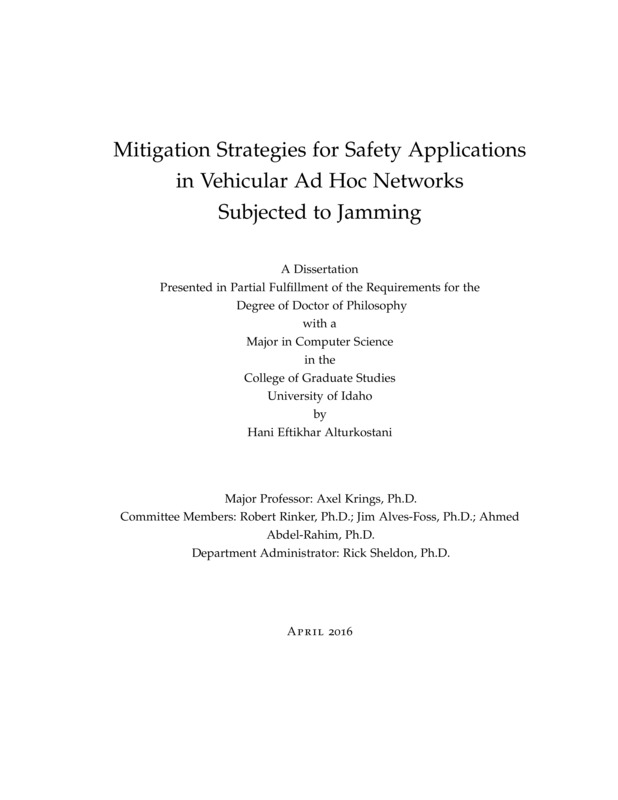Mitigation Strategies for Safety Applications in Vehicular Ad Hoc Networks Subjected to Jamming
Alturkostani, Hani Eftikhar. (2016). Mitigation Strategies for Safety Applications in Vehicular Ad Hoc Networks Subjected to Jamming. Theses and Dissertations Collection, University of Idaho Library Digital Collections. https://www.lib.uidaho.edu/digital/etd/items/alturkostani_idaho_0089e_10845.html
- Title:
- Mitigation Strategies for Safety Applications in Vehicular Ad Hoc Networks Subjected to Jamming
- Author:
- Alturkostani, Hani Eftikhar
- Date:
- 2016
- Keywords:
- DSRC Jamming Reliability Safety Application VANET WDoS
- Program:
- Computer Science
- Subject Category:
- Computer science
- Abstract:
-
The term Intelligent Transportation Systems (ITS) refers to the technologies, services, and applications that allow vehicles to communicate with each other (V2V) and also with fixed infrastructures (V2I) and (I2V). This collaborative communication forms a Vehicular Ad-Hoc Network (VANET) that enables the deployment of a wide range of useful applications to address some of transportation’s most critical elements, such as mobility, environment, and safety. A key technology to facilitate such communication is called Dedicated Short Range Communications (DSRC), which operates in the 5.9 GHz band. One of the most important applications in ITS, furthermore, are DSRC Safety Applications, which aim to enhance safety and reduce traffic accidents. The reliability of any Safety Application is crucial; any disturbance, whether benign or malicious, could lead to catastrophic consequences like injury or loss of life. Wireless jamming is considered to be a serious threat to Safety Applications due to its simple implementation and severe impact on ongoing communications. In fact, wireless jamming is capable of blocking the communication between nodes entirely and creating a Wireless Denial of Service (WDoS) attack.
In this dissertation, we propose a new series of mitigation strategies for DSRC Safety Applications in VANETs to enhance their overall reliability in the presence of jamming attacks. These mitigation strategies are as follows: 1) an adaptive threshold-based agreement algorithm, 2) a detection algorithm that enables jamming-aware Safety Applications, and 3) a recovery strategy that uses dynamic transmission and power rates. Throughout this dissertation, we discuss these mitigation strategies and investigate their usefulness using mathematical models, simulations, and field experiments. Our test results show that the mitigation strategies will help to enhance the reliability of Safety Applications in the presence of wireless jamming. In addition, the techniques recommended by this dissertation are in line with current institutional and governmental standardization efforts and will not overwhelm the communication media.
- Description:
- doctoral, Ph.D., Computer Science -- University of Idaho - College of Graduate Studies, 2016
- Major Professor:
- Krings, Axel
- Committee:
- Rinker, Robert; Alves-Foss, Jim; Abdel-Rahim, Ahmed
- Defense Date:
- 2016
- Identifier:
- Alturkostani_idaho_0089E_10845
- Type:
- Text
- Format Original:
- Format:
- application/pdf
- Rights:
- In Copyright - Educational Use Permitted. For more information, please contact University of Idaho Library Special Collections and Archives Department at libspec@uidaho.edu.
- Standardized Rights:
- http://rightsstatements.org/vocab/InC-EDU/1.0/

